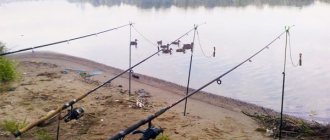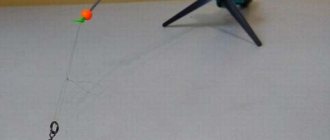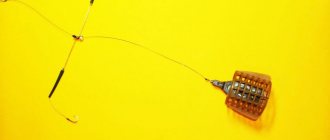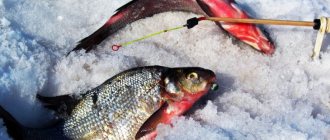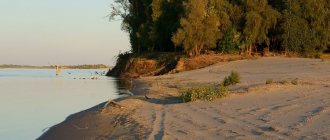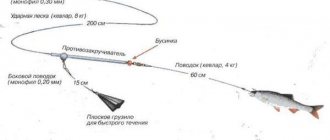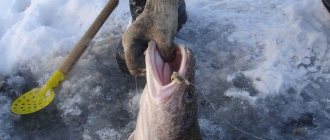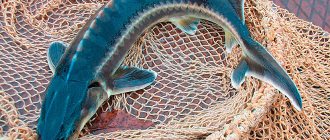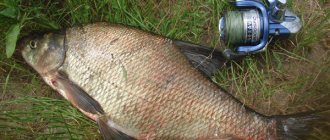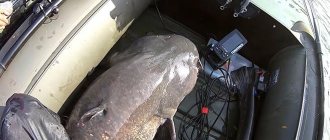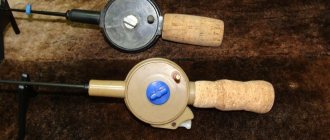What does donka consist of?
The design of the bottom tackle is extremely simple. The fishing line is wound on a spool or reel, has a large sinker, above which there are several leashes with bait.
The presence of a large sinker is necessary for long casts by hand and holding the bait motionless on the bottom even with a strong river current.
Line for tackle
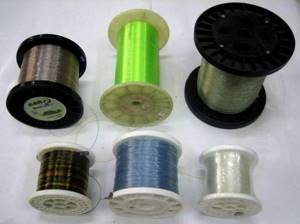
When casting, significant loads are placed on the bottom tackle, so it is recommended to choose a fairly thick fishing line. The minimum diameter is 0.35 millimeters. Since fishing with bottom tackle primarily involves large-sized trophies, the use of thick and strong fishing line will allow you to confidently catch even large and strong fish.
Sinker selection
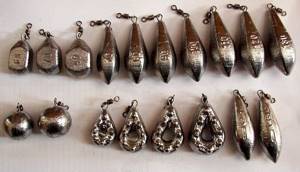
The optimal shape of a sinker for a donkey is a teardrop shape, which allows for the longest cast. The weight of the cargo can range from 30 to 100 grams. It should be noted that heavy sinkers are easier to cast, so they are more suitable for fishing in fast-flowing rivers. At the same time, it should be borne in mind that the greater the weight of the sinker, the more noise it makes when entering the water. Consequently, cautious fish may leave the fishing spot for a long time. Therefore, if possible, we recommend using weights weighing 30–50 grams.
Selection of leashes
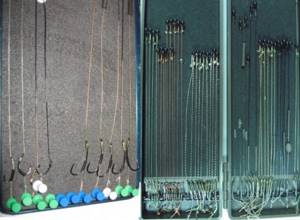
The main trophy when fishing with a donk is a large fish, so the angler must choose appropriate large and high-quality hooks. It is optimal to use hooks with a self-hooking effect; in some cases, even large-sized doubles are used.
Choosing bait

Bait selection is one of the components of successful fishing. The choice of one bait or another directly depends on the fish you are going to catch and the characteristics of a particular body of water. It is also necessary to take into account the presence of a current at the fishing site. Remember that the best bait will be food that the fish are accustomed to. This is why using expensive feeder attachments on a remote river or lake will not give the desired effect. The fish are simply not accustomed to such a bait, and will refuse to peck at it.
Try to expand the selection of attachments used as much as possible. These can be various cereals, peas, grains, dough or attachments of animal origin. It would be optimal if you use several leashes with different attachments on the donk at once. This way you can significantly increase your chances of catching. Having determined the preferred bait for fish in a particular body of water, you will subsequently be able to catch the largest and rarest trophy specimens.
Donka for carp
Bottom tackle for carp is the most catchy for this fish. But fishing for carp on a donk, due to its large size and strong resistance when fishing, requires preparation. Everything matters: the selection of the main components of the tackle, the choice of place, time of fishing, equipment, bait.
What weather should you catch carp in?
The weather does not greatly affect the activity of carp when catching it with bottom gear, both on a small lake from the shore and on a large reservoir from the bridge. We must take into account:
- Donka for carp is most effective in the summer months, when the water has warmed up to a temperature of more than 20-22 0 C. At the beginning of summer, before the heat sets in, in clear, warm weather, carp can bite throughout the day;
- In the middle of summer, with the arrival of heat, due to an increase in water temperature and a decrease in the oxygen content in it, carp becomes inactive during the day, hiding in snags, in the channel ditches of reservoirs, under steep banks at great depths. The fish are most active at this time in the morning and evening hours. Daytime activity can be observed when the heat subsides, the onset of warm, windless, cloudy weather with short rains;
- At the end of summer and beginning of autumn, the water temperature gradually drops, and the carp begins to become active not in the morning, but as the water warms up, from 9-10 o’clock. At this time, it is better to catch carp in clear, windless and not hot weather;
- In mid-late autumn, carp activity is very low - the fish become active only after a long and steady warming. Carp bite in the fall, usually in the afternoon.
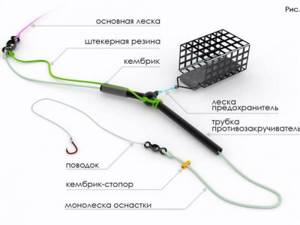
Fishing technique
In order to use bottom gear for carp fishing most productively, you should correctly perform such basic techniques as casting equipment, hooking, and fishing:
- Casting a donkey is done vertically. You should hold the rod with both hands, place your legs slightly wider than your shoulders, and stand slightly sideways. First, we lift the rod vertically, and placing it as far behind the back as possible, with a sharp whipping movement, returning it to its original position, we cast. The line with the equipment should be released at the moment when the form, describing a semicircle when moving from behind, is as parallel to the surface of the earth as possible.
- Installation of gear and alarm. After casting the tackle, we place the blank on the holder, reel in the slack and, after making a few turns of the reel, create such tension on the cord or fishing line that the tip of the blank is in a slightly bent state. We attach the bells to the top or the second knee from it; swingers, pendulum alarms are secured between the reel and the first throughput end of the butt leg of the rod. We attach simple bells to a fishing line coming out of the tulip of the rod in such a way that the alarm attached to it creates a slight slack.
- Sweeping. You should hook when the alarm is activated for a long time and there are strong jerks, visually observed at the tip of the form. Hooking is performed by briefly and sharply lifting the rod up from the stand. You should not make a sweeping and very strong hook, which can either tear the soft lips of the fish or pull the hook with the nozzle out of the fish’s mouth.
- Fishing. Small carp should be fished out quickly. When fishing, larger specimens should first be slightly tired on a line stretched like a string, and only then slowly pulled to the shore, where it must be quickly placed in a landing net with a large bucket and a strong handle.
Groundbait and spot feeding
Catching carp with a donk feeder involves using a feeder. Bait used for feeder carp fishing can be not only purchased, but also made independently. Of the baits offered by stores, the most effective are:
- MINENKO PMbaits CARP;
- DUNAEV Premium Carp Carp;
- Traper Big Carp;
Self-prepared baits for carp fishing usually include:
- Dusting components. The base is breadcrumbs, ground seeds, cake;
- Heavy particles - canned corn, peas, maggots, bloodworms, chopped worms;
- Flavorings: vanilla, garlic, honey, special carp additives.
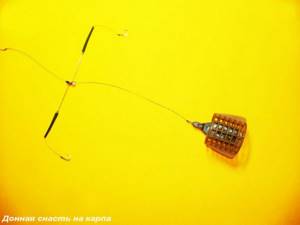
The technique of using bait when catching carp on bottom gear with a feeder includes:
- Feeding - using a larger and heavier rocket-type feeder filled with bait, we make several feeding casts at the intended fishing point. After the first cast, it is advisable to clip the cord or line so that you can continue casting to the same point.
- After 3-4 feeding casts, we wait about 25-20 minutes and, having filled the feeder with bait, placing the bait on the hooks, cast to the feeding point.
How to make donka for carp
You can make bottom tackle for carp fishing with your own hands, following simple instructions:
- We pass the fishing line through the rings of the blank and fix it on the spool of the reel;
- Under tension, we wind 200-250 m of fishing line onto the spool;
- Leaving unwound a piece equal to two lengths of the form at its end, we proceed to installation of the type of equipment most suitable for certain conditions.
Also, for carp fishing, you can assemble a classic bottom tackle on a large reel:
- To do this, we cut out a long and large reel from plywood, 20-25 cm long;
- We attach the end of a fishing line or cord to it;
- We wind 100-150 meters of fishing line or cord onto the reel;
- Stepping back from the end about 10-15 cm, we make a small double loop on the fishing line and tie a leash 15-20 cm long with a large and strong carp hook No. 6-8 hook to it;
- Having retreated 25-20 cm from the first leash, we make the second leash in the same way;
- To the end of the fishing line we tie a nylon thread 25-30 cm long with a flat sinker weighing up to 150-200 grams at the end;
- For such a line we choose a thick line, with a cross-section of 0.35 mm, for leashes we use monofilament with a thickness of 0.18-0.2 mm or a braided cord 0.1-0.12 mm.
The advantage of such equipment, compared to feeder equipment, is its compactness, the disadvantage is the difficulty in landing large fish in the absence of a rod and reel.
Donkey rigging
The equipment of the bottom tackle is a varied combination of the relative position of the sinker, feeder, leashes with hooks and connecting and anti-twisting elements. When fishing for carp, the following types of rigs are used:
Each of the equipment is used in certain conditions. So, for example, with a sliding rig, carp should be caught in reservoirs with strong fishing pressure, in lakes with a muddy and marshy bottom.
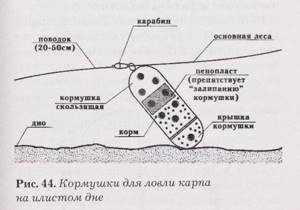
Many fishermen, while modernizing their bottom gear, also improve the rigs they use, making the gear more durable, sensitive and catchy.
Inline
This catching equipment is used on reservoirs with a hard, non-silted bottom. It is assembled very quickly and simply:
- Cut a piece of leadcore 60-80 cm long;
- We make loops at its two ends using a mounting needle;
- We install a quick-release swivel on one of the hinges;
- Using a mounting needle, we hook the leadcore to the second loop and pass it through the inner sleeve in a pear-shaped sinker weighing up to 120-150 grams;
- We recess the swivel with quick release inside the sinker sleeve;
- We attach a leash made of braided cord with hair accessories to the quick release.
This equipment is one of the simplest and does not require special skills for installation.
Its advantages include high reliability and frequent self-hooking of carp. The disadvantages are the low casting range and the inability to use on reservoirs with a muddy, marshy bottom.
Sliding equipment
Classic carp bottom equipment, assembled as follows:
- At the two ends of a piece of leadcore 80-90 cm long we make small loops;
- We attach a swivel with a quick release to one of the loops with a cape;
- Using a mounting needle, we place a locking plastic sleeve on the leadcore;
- We rest the bushing against the quick-release swivel;
- By pulling the leadcore from the opposite end, we recess the swivel into the bushing;
- We put a plastic ring with a clasp on the leadcore;
- 20-30 cm above the fastening point of the quick-release swivel, place a rubber stop bead on the leadcore;
- We attach a pear-shaped sinker weighing 100-120 grams to the clasp;
- We attach a leash with hair accessories to the quick release.
Such installation, unlike inline, does not promote self-hooking of carp, but it can be used in reservoirs with a muddy, marshy bottom. The casting range of such equipment is much greater.
Helicopter
The longest-range of all carp bottom gear, assembled as follows:
- At the ends of the leadcore section we make two loops;
- To one of the loops we attach a fastener with a pear-shaped sinker weighing 100-120 g;
- We close the place where the fastener and the leadcore loop are attached using a silicone sleeve;
- We put a swivel on the leadcore with a quick release at the end;
- We fix the movement of the swivel along the fishing line with a rubber bead;
- We attach a monofilament leash with a hook and hair rig to the quick release.
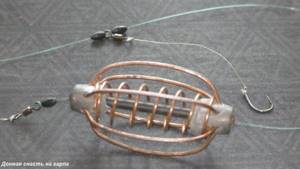
The advantages of such equipment are its high casting range and the ability to fish in reservoirs with a significant layer of silt at the bottom. The disadvantage is the frequent twisting of the leash by the leadcore when diving the gear to a depth of more than 5-6 meters.
Choosing a fishing line for carp for bottom tackle
For bottom carp tackle, you can use both monofilament fishing line and braided cords:
- When fishing in small reservoirs, ponds and stakes, where the weight of the carp does not exceed 2-3 kg, you can use high-quality monofilament with a cross-section of 0.27-0.35 mm;
- For large reservoirs, as well as ponds where trophy fish weighing over 6-8 kg are found, braided cords with a cross-section from 0.16 to 0.2-0.22 mm should be used.
When choosing a fishing line, preference should be given to special carp models that are characterized by high strength and durability.
Catching carp on a donk with a feeder
Catching carp on a donk with a feeder - a feeder - involves the use of appropriate gear:
- The rod is used with a length from 3.6 to 4.2-, 4.5 meters with a fast action and a cast of over 100 g;
- The reel is inertia-free, with a size of at least 4000-4500, with 3-6 bearings and a gear ratio of no more than 5:1;
- When fishing for carp on a feeder, a strong cord with a cross-section of 0.18-0.22 mm is used, monofilaments are used even thicker - 0.25-0.35 mm;
- Feeders - rectangular and round, metal, weighing from 60-80 to 90-100 grams.
Catching carp with this tackle is effective in reservoirs and large lakes with a small layer of silt at the bottom. The best season for catching carp with this tackle is mid to late summer.
Feeders for various fishing conditions
When fishing for carp using bottom gear, both feeder and specific carp feeders are used:
- Open - without plugs on both sides;
- Semi-closed - there is a plug at one end that prevents feed from spilling out to the bottom;
- “Method” type feeders are flat, covered with bait, in which hooks are hidden.
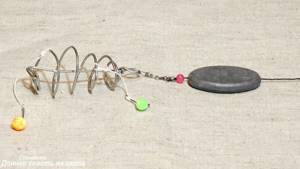
The use of one type or another depends on the structure of the bottom and the presence of current:
- When fishing for carp on rivers with a small current and in places with a very muddy bottom, semi-closed type feeders are used so that when the equipment falls to the bottom, the bait is not quickly washed out by the current of water or does not get stuck in a layer of silt.
- Open type feeders, as well as the “method”, are used on ponds and lakes with standing water and a relatively hard bottom.
Donkey complete set
In addition to fishing line and equipment, the most important elements of classic carp bottom gear are the reel and rod.
Rod
To catch carp with various bottom rigs, with the exception of feeder rigs, special carp rods are used, which are distinguished by their strength, reliable design, forward reel seat 3.3-4.2 m long with a test weight of up to 100-120 g.
Coil
- Case material - alloy or durable carbon fiber;
- Size - from 3000−4000 to 5000−6000;
- Friction - rear;
- Number of bearings from 4 to 6−7;
- Gear ratio 4−4.6:1;
- A bayrunner is required;
- Weight - 250−300g.
Donk fishing
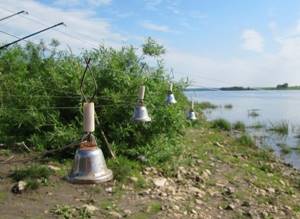
As a rule, anglers who fish with bottom gear use not one, but several bottoms at once. This allows them to occupy a large area of the shore, which increases the chances of catching.
A donkey reel or a reel with a small spinning rod must be carefully secured to the shore. Since fish can bite sharply and intensely, an unsecured reel can simply be pulled into the water. If possible, it is recommended to braid the fishing line behind bottom snags on the shore or small trees.
When choosing a fishing area, you need to give preference to places without snags and algae. Also not recommended is a rocky bottom, where the likelihood of snags increases. The optimal time for fishing is evening, night and morning. It is recommended to install donks in the evening and check them in the middle of the night.
In most cases, there are no difficulties with casting. It is necessary to swing the heavy load like a pendulum and release the fishing line. Pre-wind the required length of fishing line from the reel and lay it in neat rings. It is quite possible that initially you will have some difficulties with casting, but after a little training you will be able to throw the sinker 50 meters or more.
Using donks with a rubber shock absorber
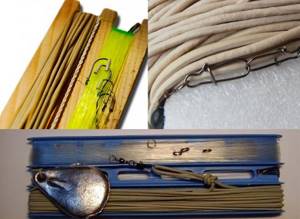
Many anglers, when using a donkey, have encountered the problem of silent casting. The solution to this problem was the use of special rubber shock absorbers, which made it possible to silently make repeated casts.
Advantages of donks with rubber shock absorbers:
- You can deliver bait to one place you feed.
- Completely silent repeated casts.
- Possibility of the so-called bait game.
- There is the possibility of spot feeding.
- A large number of leashes on the donk increases the chances of success.
Among the shortcomings, it is only necessary to note the fact that the rubber quickly breaks down and needs to be replaced.
This gear consists of:
- Safety line with a cross section of 0.5 millimeters.
- A heavy sinker on a nylon meter leash.
- Shock-absorbing rubber with a length of about 10 meters.
- Lines with leashes at a distance of several meters from each other.
- The main line with a diameter of 0.35 millimeters.
Possible difficulties may arise only when casting the sinker for the first time. In this case, we can recommend that you use a boat that will allow you to silently lower a heavy load to the desired fishing spot. Don’t forget to tie a foam float to a heavy sinker, which will allow you to retrieve the tackle if it breaks. After finishing your fishing, you can safely row your boat to the foam float and take out your gear.
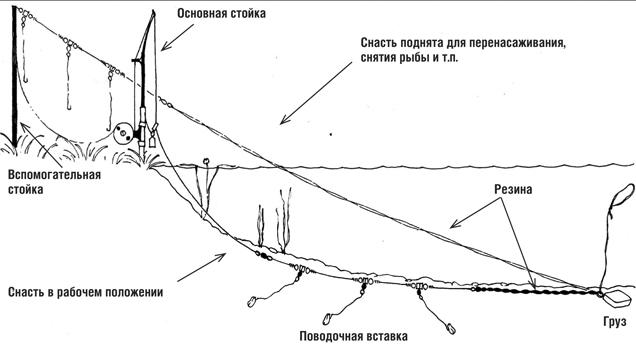
Before you start fishing, you need to properly prepare your gear. A donkey with an elastic band has two reels, one of which contains a fishing line with an elastic band, and the second has a safety rope. It is necessary to place the reel at a distance of 5 meters from each other. Calculate the required number of turns of fishing line that you will need for an accurate cast. It is necessary to lay the turns of the line in such a way that when casting, the upper turns begin to unwind, which will avoid the possibility of tangling the line. Do not forget about the presence of insurance, which unwinds several meters more than the main fishing line with an elastic band.
“Remember that it is necessary to place a fishing line with bait after casting a donkey with an elastic band”
The connection is made using carabiners, and after fishing is completed, the carabiner is unfastened. All you have to do with the help of insurance is to get the cargo out of the water. Store elastic rigs on separate reels. This will ensure its safety and durability.
Spinning rods for donkey
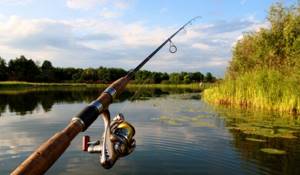
Initially, the classic donka was an exclusively hand-made tackle. However, later spinning rods, the reel of which was actually used instead of a reel, became very popular.
With minor modifications, the donkey spinning rod began to be called a feeder. This type of tackle is very popular today and allows you to catch a variety of large fish. The popularity of the feeder is explained by the ease of fishing, the availability of gear and the ability to catch maximum trophies. At the same time, it is necessary to take into account that the feeder is a rather specific piece of equipment, which in unfamiliar conditions on new lakes and rivers may not give any results at all. But in those places where anglers often fish with a feeder, its effectiveness is at a high level.
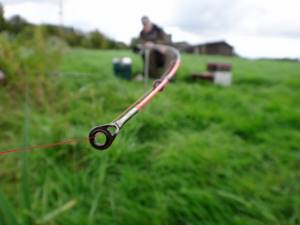
Using a spinning rod for donkey allows you to significantly simplify the process of throwing bait. In this case, there is no need to use expensive reels, which are necessary for classic spinning. We also note that the process of landing fish has been significantly simplified. If previously, when using a reel, everything actually had to be done manually, then with the use of a spinning rod and reel you can optimally catch even the strongest fish. The risk of fish falling off the hook is reduced, since you can optimally select the line tension when landing fish.
About 50 meters of fishing line with a thickness of 0.3 meters is wound onto the reel. The leashes are attached to the main line using a carabiner, and the heavy weight makes it easy to cast to the maximum possible distance. In total, when purchasing Chinese reels, the total cost of the gear can be several tens of dollars.
Spring
This type of feeder is used for catching white fish in reservoirs without a current. This feeder is mounted together (or together) with a sinker. The leash is mounted in close proximity to the feeder.
The feeder is filled with food before casting (millet or purchased bait. The hook is equipped with a nozzle. After that, the hook is immersed in the bait. After casting, the bait is washed out of the feeder along with the bait.
The springs are mounted to the main line using a sliding type of equipment.
Donkeys with a feeder

When casting far, which is practiced when fishing with a bottom, the angler may encounter the problem of baiting fish. How to accurately deliver bait to the site of an abandoned donkey? As a result, the idea was born to modernize the gear, which received a small feeder attached with a carabiner.
Feeder spring
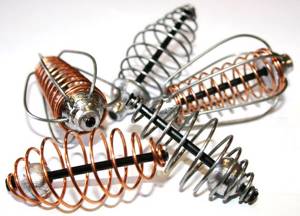
Many fishermen made primitive homemade feeders from small springs. Today, such spring feeders are effectively used for bottom fishing.
The main object of fishing with spring feeders is white fish. Such fish include bream, bream and carp. In rare cases, crucian carp and silver carp are caught using springs. The choice of bait and bait for fishing largely depends on the specific characteristics of the reservoir and the preferences of the local fish.
Feeder container
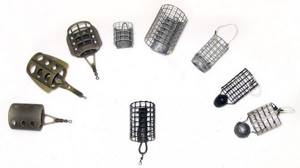
In specialized stores you can find dozens of different models of feeders, which differ in their weight and shape. They are designed for various fishing conditions and various purposes. However, they are united by the fact that the main purpose of the feeder is to attract fish.
Such feeders are very popular when fishing with a feeder. You can make your own feeder from metal wire and lead. You can also purchase ready-made varieties of feeders in specialized stores. Their cost is not high, but at the same time they are effective and allow you to lure fish efficiently, thereby increasing the chances of success.
Remember to use the same bait on the bait and on the hook. This will allow you to successfully catch even the most cautious and large fish.
Bite alarms for bottom fishing
- Mechanical alarms
Theoretically, such a signaling device can be any object that can bend a stretched fishing line. In donkeys without rods during times of general shortages, the following were used as bite alarms: a piece of wet clay, a small branch, dough and other alarms. The bell was considered the most universal bite alarm.
This alarm has been used in bottom fishing since time immemorial. It was attached to the main line using an eraser, a special clothespin and other methods.
An alternative to a bell was a bell. Alarms are good because of their versatility. Can be used both in day and night bottom fishing. There is only one drawback to this type of alarm: strong winds can reduce their effectiveness. It is necessary to use limiters in the equipment.

- Electronic bite alarms
This type of alarms appeared on the market not so long ago. With a certain stretch, it can be considered the best among alarms for night fishing. In case of a bite, it gives a signal - a squeak, which can be heard at a fairly long distance. Each alarm can be set to a specific tone, so in the dark you can determine by the sound which donkey has “triggered.” Most of the electronic signaling devices duplicate the sound signal with a light signal, which is clearly visible in the dark. Some fishermen make such signals on their own, but purchasing one in a store is also not difficult.
- Other types of alarms
The simplest bite alarm is the rod tip. There are special fishing rods in nature with a replaceable flexible tip, which serves as a bite indicator for bottom fish - feeder and picker rods. They differ only in design (feeder rods consist of three legs, picker rods - of two) and sensitivity (picker rods are more sensitive). Replaceable quiver tip allows you to adapt the rod to any fishing conditions.
But, in principle, the tip of any rod, if installed correctly, can serve as a bite alarm. At least big fish.
Bite alarms for donkeys
Bells
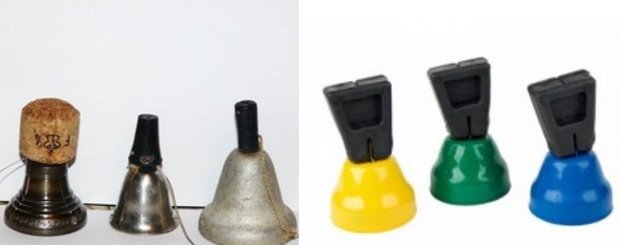
For many years, the most popular bite alarm for bottom rods was a simple bell. It was attached to the sagging main line directly at the reel or rod. We can say that such bells are the best option for gear without a rod.
Electronic bite alarm
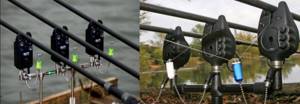
As new technologies emerged, mechanical bells began to improve. Special waterproof electronic alarms appeared that emitted a characteristic sound when biting. Also, such alarms were equipped with light indication. The only drawback of such electronic bite alarms is their relatively high cost.
Bells
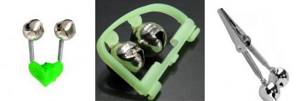
Bells are a rather interesting version of a bite alarm, which is located at the tip of the fishing rod. The only drawback of such a signaling device is the lack of a bite in cases where the fish, after taking the bait, goes to the angler. In such cases, the bells do not signal a bite, and the line simply sags.
Modernized versions of bells have a special niche for installing light indicators. This will allow you to successfully use them for night fishing.
The tip of the rod as a bite alarm
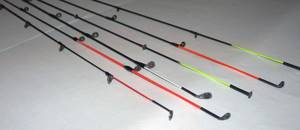
It is possible to use the rod itself as an excellent signaling device. When a large fish bites, the tip of the fishing rod begins to bend and tremble. At the same time, it should be borne in mind that such alarms are only suitable for daylight hours and require constant attention from the fisherman to the fishing rod.
Types of Snacks
- with a sliding sinker. The hook is tied at the end of the main line below the sinker. Between the sinker and the hook there is a stopper in the form of a bead, cambric or knot to prevent the sinker from rolling towards the hook;
- with a sliding sinker. Below the sinker, one or two leashes with hooks are tied (if more, then there are more snags and breaks in the tackle). A stopper between the sinker and the leads is required;
- with an end sinker. The leashes are tied into loops on the main line above the sinker. The distance between leashes varies up to 1 meter. The length of the leashes should not allow them to cling to each other. Leashes are made removable using carabiners.
The donk is thrown by hand. Casting range up to 50 meters. The fishing rod is a reel. After casting, the reel is stuck into the bank.
The signaling device is a bell, a weight, or a twig suspended on a fishing line near the reel. The sag of the fishing line under the weight of the alarm should indicate a bite when the gear is tensioned and loosened.
The weight of the main sinker (up to 60-200 grams) depends on the speed of the current in the reservoir and should guarantee the necessary line tension for a clear bite signal. The most effective bait is for night fishing for catfish and burbot, which are not particularly sensitive to rough tackle.
Important! When fishing at night, you need to have a supply of leashes and sinkers - breakage of the gear is possible, especially on a rocky bottom, and burbot is apt to swallow the hook very deeply. It’s easier to leave a swallowed leash in the fish and remove it at home, and put a spare one when fishing.
An alarm is not installed when fishing for burbot at night. They go around the donks and check them every hour to an hour and a half.
Donkey rigging
Today there are dozens, if not hundreds of different equipment for donkeys. It is simply impossible to describe them all. Let's focus on the most common and reliable options.
Simple option
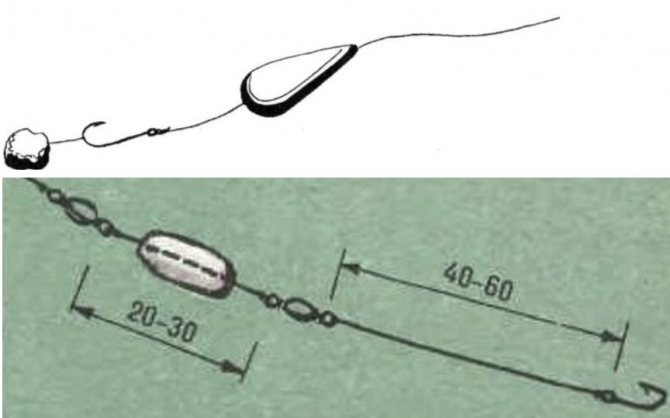
Despite its simplicity of equipment, this option is perfect for fishing for the largest trophy fish. In this case, only one node is used, so the strength of the equipment is beyond doubt.
We attach a sliding sinker in the form of a teardrop shape or an olive to the fishing line. To fix the sinker, you must use a silicone clamp. Remember that the stopper must be fixed firmly and rigidly enough. When casting the tackle, a significant load is placed on the stopper, but at the same time it must maintain its position. We can recommend that you use a soft lead pellet, which is clamped on the fishing line, as such a reliable stopper. A hook is tied to the end of the fishing line without a leash. It is also possible to rig it using a leash, which is attached through a swivel.
Equipment with spring
With equal success, a donkey rig with a spring is suitable for fishing with a rod and with hand casting. Equipment with a spring is especially effective when fishing in lakes and rivers with calm water.
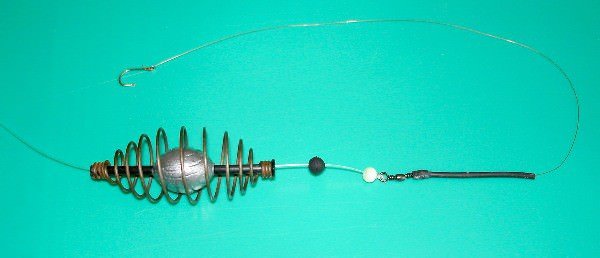
The first option is a sliding donkey with a spring. In our case, we replace the sliding sinker of the donkey with a spring. Viscous porridge or peas are easily stuffed into the spring. The choice of bait directly depends on the type of fish and its specific preferences in your pond.
The advantage of sliding equipment is that the fish does not feel resistance when biting, which is necessary for catching cautious and large fish.
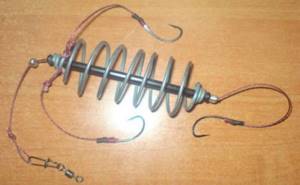
In the second version of the rig, short leashes are installed on the spring, which are recessed into the bait located in the spring. In fact, in this case, the bait is used as feeding and bait. The second option is perfect for catching bream and carp. In this version of the equipment, the fish detects itself, and the angler only needs to pull it out of the water. We can recommend that you use braided fishing line with a thickness of 0.1 - 0.15 millimeters for leashes.
If you are fishing in a strong current or there are deep holes and a sharp change in depth, it is recommended to install flat sliding sinkers directly in front of the spring. Such a flat shape of the sinker will not allow it to be carried away by the current.
